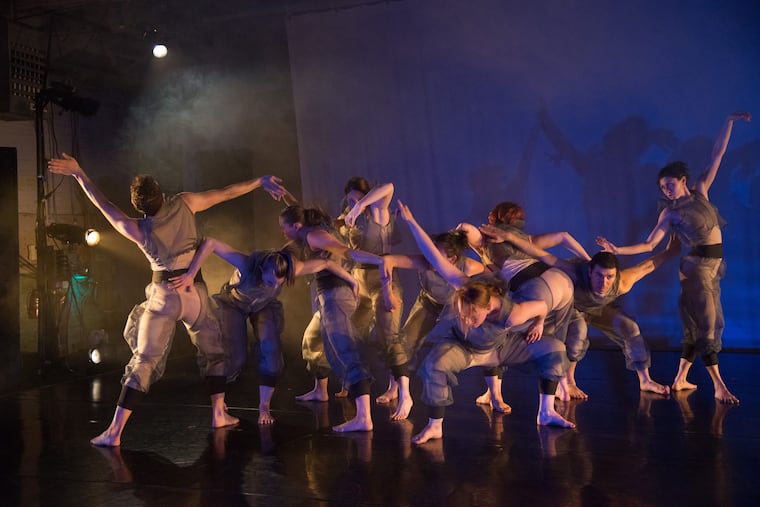Group Motion, Philly’s modern dance innovator, throws itself a 50th birthday bash for the ages
The innovative Group Motion troupe helped create Philadelphia's avant-garde dance scene. It celebrates its 50th anniversary with a gala performance, an open-to-everyone workshop, and a book party.

The avant-garde Group Motion dance troupe of Philadelphia does more than dance. Its members choreograph and present new works, tour nationally and internationally, train teachers in their innovative methods, and are known for their groundbreaking commitment to improvisation and to multimedia performance.
Just as important is their all-Philly Friday night workshop, held weekly at the Community Education Center on Lancaster Avenue in West Philadelphia — led by artistic director Manfred Fischbeck and former co-director Brigitta Herrmann — where Group Motion introduces nondancers to the pleasures of expressing themselves through movement.
These drop-in sessions, held since 1971, incorporate meditation, interactive games, and accompaniment by drums and keyboard. For two hours, participants are guided by Herrmann and Fischbeck in a series of "structures," including the popular active-passive, where one person "sculpts" the other, moving that individual's head or arm into various positions.
Fischbeck and Herrmann have taken the concept around the world, but this is home base.
Megan Bridge, who danced with the company from 2000 through 2005 and who now co-directs the Fidget multimedia dance collaborative and performance venue in Kensington, is one of the alumni returning to dance in celebration of the troupe's anniversary and impact. "Group Motion's presence created an environment in which [avant-garde] dance could grow and thrive," she says.
There will also be a Group Motion workshop on July 1 open to anyone, no dance experience required.
On that evening, there will also be a book party marking the publication of Group Motion in Practice: Collective Creation Through Dance Movement Improvisation, a combination memoir, philosophical treatise, and guide to the "improvisational structures" (theater games) that Group Motion has used to inspire dancers, actors, musicians, and nonperformers since its founding.
Fischbeck and Herrmann trained in their native Germany. When they moved to Philadelphia in 1968 to establish Group Motion here, along with Hellmut Gottschild, now professor emeritus of dance at Temple University, there was nothing much on the local dance scene, Fischbeck says. "There was the Pennsylvania Ballet and Arthur Hall [whose company presented African dance], plus [modern dancer] Joan Kerr."
BalletX didn't come along until more than three decades later. Rennie Harris was only 4 years old at the time. Gottschild started his own influential company, ZeroMoving, in 1972.
The first U.S. performances of Group Motion — including a groundbreaking multimedia piece – -were hits at the Judson Church and at Jacob's Pillow, prestigious venues for avant-garde dance in New York and Massachusetts. Group Motion was also a success in Philadelphia. "We had 300 people, at the [Gershman] YMHA," Fischbeck recalls.
Fischbeck and Herrmann married — they're now divorced — and have two daughters, Laina and Aura, both now professional dancer-choreographers. Laina created and dances with the French troupes DEAD Company and LIVE Company. Aura heads San Francisco's Aura Fischbeck Dance.
The couple, both now in their late 70s, continue working, both separately and together. They and Gottschild memorably appeared with the young performers of BalletX in Nicolo Fonte's "Beautiful Decay," which premiered in 2013 and which was revived last year.
>> READ MORE: BalletX 'Beautiful Decay' a passionate reminder that dancers don't 'age out' of talent
Fischbeck and Herrmann's desire to make dance accessible to everyone has led them to take Group Motion to psychiatric hospitals, senior residences, airports, prisons, and hundreds of schools. During these visits, he says, "we perform a bit, but the main focus is to get [everyone there] to respond."